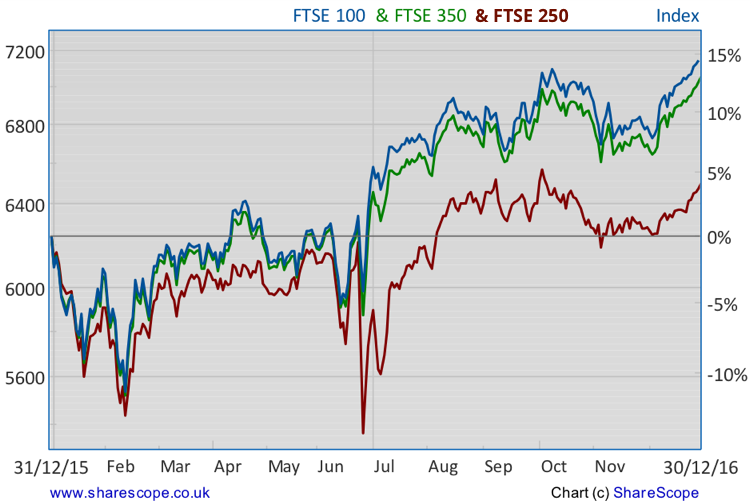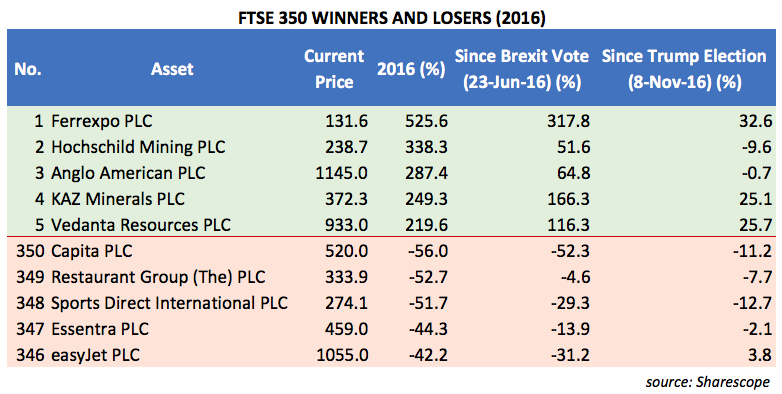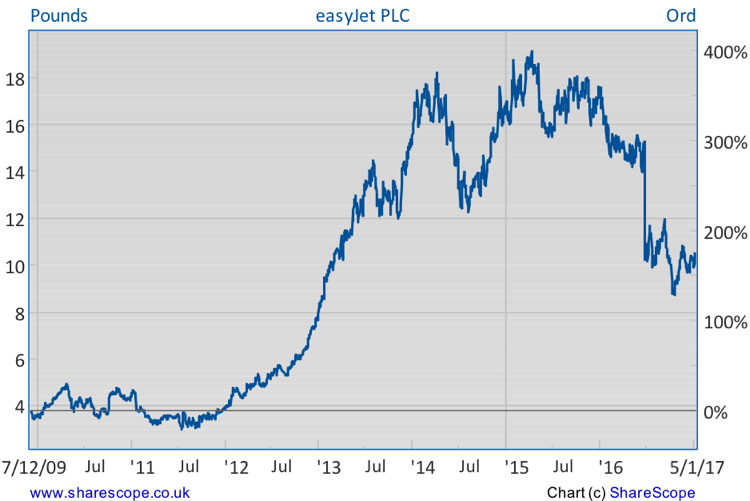2016: A year in perspective

I wish all our readers a Happy New Year! I hope you all enjoyed the festive period and are now prepared to fasten your seat bells for a market journey that is expected to be even more exciting than 2016.
After the Brexit vote, the Trump win, the Indian experiment, and more besides, it’s time to knuckle down and face new challenges that will come in the form of tough European elections, a shift in focus from monetary to fiscal policy, and the start of a new era where low interest rates may not be the new norm that many first believed.
While 2016 is already part of history, looking through the rear-view mirror may help us get a sense of perspective for 2017.
A bad start
After getting off to a very weak start, 2016 actually turned into a year of solid performance in financial markets. By mid February, both the FTSE 100 and the S&P 500 were down by more than 10%, while oil had lost more than 25%. In the commodities complex, only precious metals were safe, with gold and silver up by 17% in the period.
The first rate hike in a decade occurred in December 2015, and the promise made by the FED to hike a further 2-3 times in 2016 led equities lower and weighed heavily on emerging markets.
The case for oil was even more complex. Plagued with a prolonged weakness in demand coupled with an oversupply problem, OPEC was unable for most of the year to stabilise the oil market. Only by the end of November, when some kind of agreement was finally reached, did this market seem to have stabilised.
Nevertheless, the path to recovery was tough and there were many casualties along the way. One of those casualties was Venezuela. The USD/VEF exchange rate rose an incredible 58% in 2016, reflecting the severe strain Venezuela has been under due to its huge dependency on oil exports. The country has no reliable economic indicators but GDP probably declined by double digits while inflation likely neared four digits.
Venezuala entered the record book Hanke-Krus World Hyperinflation Table at number 57th, with a peak monthly inflation of 221%. Since Nicolas Maduro came to power, consumer prices have risen 4,200%. Venezuela will continue to feel the pain next year, as the central bank is short on foreign reserves and will be forced to hike interest rates, at a time when the country is mired in heavy recession.
While oil prices are now on the recovery path, there’s no reason to believe they can reach the three-digit levels of the past.
The Venezuelan case is an important lesson for all those countries that rely on oil. Such is the case with Saudi Arabia and Russia, both of whom have survived so far but will most likely encounter trouble in the future.
While oil prices are now on the recovery path, there’s no reason to believe they can reach the three-digit levels of the past. Decades of high oil prices inspired the fracking industry in the US and alternative energies that will pump energy into the market whenever oil prices start rising too much. This serves as a warning to oil producers for the future.
Then comes Brexit
While the January-February turbulence and the oil market imbalances marked the beginning of the year, the first major event occurred in June, when the British took to the polls about their future in the EU. Surprisingly (or at least against the odds), the Brexit case prevailed and a new trend began in the markets. Since then, sterling has lost 16% against the dollar and 13.5% against the euro.
In theory, Brexit renders sterling less attractive, thus requiring a new equilibrium at depreciated levels. To some extent this has played quite nicely for equities and the FTSE 100, which gathered pace reaching a total return for the year of around 19%. A large part of the rise occurred after the Brexit vote and as a consequence of it.
The components of the FTSE 100 make a large part of their earnings outside the UK, which means that, at depreciated sterling levels, they earn a lot more in sterling terms, for the same business. The FTSE 350 was also pushed higher but by much less (+12.5%).
While the Brexit result played very well for British equities, those effects are now fading as Brexit negotiations enter a new level of intensity. As for the outcome, only time will tell, but for the time being I would say that nothing significant is changing.
Of much more importance than Brexit is the exact direction taken by fiscal policy. Chancellor Philip Hammond has already departed from Osborne’s tightening plans, which at this point may act as a strong relief for the economy. Unlike what many believe, I don’t think 2017 will be a poor year for the British economy. The country may experience a relatively strong economic performance.
Trump and his impact
Later in the year came the second big shock when Donald Trump was elected US President. I believe that even Trump was taken by surprise.
The new president promised to scrap trade agreements, build a wall between the US and Mexico, and turn to protectionism (amongst many other eccentric measures). But, in contrast to the prediction of many in the media and the ‘establishment’, his influence in the markets has been positive.
From an initial negative reaction, markets completely reversed the trend and turned bullish on Trump’s election victory. After all, Trump could be exactly what the world was in need of, as he has revived prospects for economic growth and inflation.
In a world plagued with sluggish economic performance, deflation, negative interest rates, extended asset purchases, unattractive savings remuneration, and central bank hegemony; the prospects for a change acted as a breadth of fresh air to the world’s economy.
I have a strong bet on the db x-trackers DJ STOXX 600 Banks (XS7R) and I expect to keep it for some time…
A big winner has been the banking sector, which was saved by central banks in 2008-2009 but since then has been depressed due to zero/negative interest rates. I have a strong bet on the db x-trackers DJ STOXX 600 Banks (XS7R) and I expect to keep it for some time, as the sector has been a big winner and may benefit from higher interest rates and inflation.
Another big winner has been the BoJ. After having battled the lack of growth in nominal GDP for decades, the Japanese central bank adopted desperate measures like negative interest rates and yield control, but nothing worked so well as the Trump boost to the dollar, which pushed the USD/YEN 10% higher in less than two months.
The ECB will continue to lag behind the FED because the European economy is in a much more fragile state than the US economy, but we shouldn’t expect much more from the ECB in terms of easing. In December, Draghi announced an extension of the current asset purchase programme by nine months, which puts the end of the programme at December 2017. But, at the same time, he trimmed purchases from €80 billion to €60 billion, which is a kind of tapering (but please don’t use that word near Draghi!).
I believe the euro will perform well against the dollar in 2017 and I’m keeping my long position on EUR/USD.
I believe the euro will perform well against the dollar in 2017 and I’m keeping my long position on EUR/USD. There is too much optimism regarding the US and too much pessimism regarding the EU, which means the margin for surprises hitting the euro is small. On a side note, the latest inflation figures coming from Germany are on the positive side which further erodes any easing prospects for the ECB.
The major shift ignited by Trump is already pushing yields higher. One year ago, one had a hard time finding something positive in Europe but now a 10-year German bond yields 0.25%; its counterparts in the UK and US yield 1.32% and 2.35% respectively. I’m still bullish on the Proshares Short 20+ year Treasury ETF (TBF) and on the iShares Euro Government Bond 15-30 (IBGL). These seem like effective plays on inflation and interest rate rises.
Although the market reaction to Trump’s victory has been favourable, he remains a divisive figure. Mexico is certainly unhappy with recent developments, as Trump is the biggest threat the country has ever faced to its economic prospects.
Building a wall along the border pales in comparison with the recent threats over car makers. Many US car makers that invested heavily in Mexican production facilities are rethinking their strategy and may end up relocating to the US. Given the significance of automotive exports for the Mexican economy this is a major blow.
I’m still bullish on the Proshares Short 20+ year Treasury ETF (TBF) and on the iShares Euro Government Bond 15-30 (IBGL).
Banxico, the central bank of Mexico, will have troubled times ahead. Interest rates will go higher and the economy will deteriorate. The dollar rose 20% against the Mexican peso in 2016, a trend that will be difficult to reverse.
Mexican equities have been in trouble and I believe they will face more trouble ahead. Still, I don’t like to follow the herd and I think we may be closer to a turning point. I’m adding the iShares MSCI Mexico Index Fund (EWW) to my watchlist. Not buying, just watching.
Recovery plays
A few final words are reserved for British shares. Looking at the top tables, it is impressive to see how well the mining stocks fared in 2016: Anglo American (LON:AAL) (+287%), Kaz Minerals (LON:KAZ) (+249%), Vedanta (LON:VED) (+220%), Glencore (LON:GLEN) (+207%), just to mention a few, have done quite well. The FTSE 350 mining sector rose 101.5% in 2016.
In this particular case, I’m not opposing the trend as I still expect metals to do well in 2017, partly because I expect inflation to rise faster than central banks’ willingness to hike interest rates. I’m retaining my bet on gold miners through the GDX and GDXJ ETFs.
My last words go in favour of easyJet (LON:EZJ). Shares in the low-cost airline have been severely battered since Brexit, having plunged 33% in the two weeks following the vote. But, as the situation regarding Brexit stabilises and as data from the company came in much better than many first thought, I’m increasing exposure to the stock.
Passengers increased 6.6% in the year from 69.8m to more than 74m, with an increase in December alone of more than 16% (compared with the same period previous year). Those numbers don’t fit well with the 42% loss the shares incurred in 2016.
Good luck in 2017!



Comments (0)